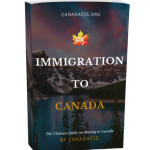Converting Your Temporary Work Permit to Canada PR
Home » Blog » Work in Canada » How to Turn Your Temporary Work Permit to Canada PR
It may seem like a lengthy and difficult procedure to convert your temporary work permit to a Canada PR, but don’t worry! You may accomplish this in a number of quick and simple methods without putting too much time or effort into it.
You might wonder how that is. The best path, and more are all provided for you right here. Keep reading to get more helpful information that you won’t want to miss!
Table of Contents
📃 How to Turn Your Temporary Work Permit into a Canada PR
The easiest approach to convert your temporary work permit into permanent residency in Canada is to apply to one of Canada’s popular immigration pathways.
Changing your temporary work visa to a permanent one is very definitely possible. How? The top 4 best pathways are presented in the sections that follow.
💼 BEST CHOICE: Express Entry
Points are assigned based on various criteria within the Express Entry Comprehensive Ranking System (CRS).
Under the Express Entry CRS grid, temporary work permit holders can earn points for their Canadian job experience.
Canadian job experience can contribute to earning up to:
- 70 points in the Core/Human Capital element.
- Up to 100 points in the Skills Transferability factor.
Additionally, individuals with a legitimate employment offer can earn up to an extra 200 points.
A work permit holder who has legal work experience and a job offer qualifies for Express Entry with a large points advantage over other candidates, which increases their likelihood of being invited to apply and, ultimately, of receiving Canada permanent residency.
There is one stream in Express Entry you could consider, which is the Federal Skilled Worker Program.
Federal Skilled Worker Program (FSWP)
You may be qualified to apply for permanent residency under the Federal Skilled Worker Program if you are employed temporarily by a Canadian firm and the employer has offered you an offer of permanent employment. Arranged job is the term used to describe such an offer.
The temporary employee must get the requisite number of points under the Foreign Skilled Worker Program. Points are given depending on the candidate’s educational background, age, adaptability, language proficiency, and the job offer. Up to 12 to 18 months may pass throughout this process.
To be eligible for the FSWP, you must meet the following criteria:
Skilled Work Experience: You must have at least one year of continuous full-time or equivalent part-time skilled work experience in a qualifying occupation within the last ten years. The work experience must be in Skill Type 0 (Managerial Occupations), Skill Level A (Professional Occupations), or Skill Level B (Technical Occupations and Skilled Trades) of the National Occupational Classification (NOC) system.
Language Proficiency: You must prove your proficiency in either English or French by taking an approved language test (e.g., IELTS for English or TEF for French). You must meet the minimum language threshold specified by IRCC.
Educational Qualifications: You must have at least a Canadian secondary (high school) or post-secondary certificate, diploma, or degree OR have an Educational Credential Assessment (ECA) report from a recognized authority to prove that your foreign education is equivalent to Canadian standards.
Settlement Funds: You must demonstrate that you have sufficient funds to support yourself and your family members in Canada.
Express Entry Profile: You must create an Express Entry profile and enter the Express Entry pool. The system assigns a Comprehensive Ranking System (CRS) score based on various factors, such as age, education, work experience, and language proficiency.
Invitation to Apply (ITA): Candidates with the highest CRS scores receive invitations to apply for permanent residency in Canada through regular Express Entry draws. Once invited, candidates have a limited time to submit their application for permanent residency.
Admissibility: Applicants must also meet the admissibility requirements, which include passing medical and security examinations.
When applying for the FSWP, you will typically need the following documents:
Passport: A copy of your valid passport.
Language Test Results: Copies of your language test results (e.g., IELTS or TEF).
Educational Documents: Copies of your educational certificates, diplomas, and transcripts.
Work Experience Documents: Letters of reference from past employers, detailing your job duties and work experience.
Educational Credential Assessment (ECA): If applicable, the ECA report from a recognized authority.
Express Entry Profile: Proof that you have created an Express Entry profile.
Settlement Funds: Bank statements or other financial documents to prove your ability to support yourself.
Police Clearance Certificate: Depending on your country of residence and history, you may need a police clearance certificate.
Medical Examination: Proof of a medical examination conducted by an approved panel physician.
Other Supporting Documents: Any additional documents requested by IRCC during the application process.
👨🏭 Option #2: Canadian Experience Class (CEC)
The Canadian Experience Class program accepts applications from temporary workers in specialized occupations who have worked in Canada. This is a popular choice for temporary workers who fall short of the points needed to qualify for the federal skilled worker program.
Here’s what you should know:
Eligibility Criteria: To be eligible for CEC, you must have at least one year of skilled work experience in Canada within the last three years before applying. The experience should be in a National Occupational Classification (NOC) Skill Level 0 (managerial occupations), Skill Level A (professional occupations), or Skill Level B (technical and skilled trades) occupation.
Language Proficiency: You must prove your proficiency in English or French by taking a recognized language test, such as the IELTS or TEF. Meeting the minimum language threshold is essential.
Status in Canada: You must have legal status in Canada during the period of your qualifying work experience. This means you should have held valid temporary resident status (e.g., work permit) throughout your work experience.
Work Experience: Your work experience should be full-time (or an equivalent amount in part-time) and paid. Volunteer work or unpaid internships do not count toward the CEC work experience requirement.
Canadian Education: While not mandatory, having a Canadian educational credential can be beneficial and may enhance your eligibility. If you have a Canadian degree, diploma, or certificate, you should ensure it is recognized and accredited.
Express Entry Profile: To apply for CEC, you must create an Express Entry profile and meet the eligibility requirements. You will be assessed based on a Comprehensive Ranking System (CRS), which considers factors like age, education, work experience, language proficiency, and adaptability.
Invitation to Apply (ITA): To become a permanent resident through CEC, you must receive an Invitation to Apply (ITA) in a round of Express Entry draws. ITAs are issued to candidates with the highest CRS scores.
Proof of Funds: You do not need to show proof of settlement funds when applying through CEC, as you are expected to be already working and residing in Canada.
Medical and Security Checks: Applicants must undergo medical examinations and security checks as part of the application process.
Processing Times: Processing times for CEC applications can vary based on the volume of applications and other factors. You can check the most current processing times on the official website of Immigration, Refugees, and Citizenship Canada (IRCC).
Permanent Residency: If your CEC application is approved, you will receive permanent resident status in Canada, granting you the right to live and work anywhere in the country.
Path to Citizenship: After becoming a permanent resident, you can eventually apply for Canadian citizenship, provided you meet the residency and other requirements.
👷♂️ Option #3: Provincial Nominee Programs (PNP)
The majority of provinces have their own provincial nominee programs that let them nominate potential immigrants to apply for Canada PR. Candidates who submit an application for a provincial program must plan to live in the province in question. Programs frequently mimic those offered at the federal level, despite the fact that the many streams and alternatives available in each province might vary substantially.
Here are the things about PNP that you should take note of:
PNPs are designed to give provinces and territories more control over immigration to meet their unique needs. They can nominate candidates who will contribute to their local economies and communities.
Each PNP has its own eligibility criteria, including requirements related to age, education, work experience, and language proficiency. These criteria can vary widely between provinces and territories.
Most PNPs consist of multiple streams or categories targeting different groups of individuals, such as skilled workers, entrepreneurs, investors, students, and semi-skilled workers. Some provinces even have streams dedicated to specific occupations in demand.
Many provinces and territories have Express Entry-aligned streams within their PNPs. These streams allow candidates in the federal Express Entry pool to receive additional points or priority processing if they meet the requirements of a particular PNP stream.
Some PNPs have streams that enable employers to nominate foreign workers for permanent residency. These streams often require a job offer from a local employer.
Proficiency in English or French is typically required for PNP eligibility. Applicants must often provide language test results, such as IELTS or TEF.
To apply for a provincial nomination, candidates typically follow a multi-step process, including submitting an Expression of Interest (EOI) or application to the province or territory, receiving an invitation to apply if eligible, and going through a selection and nomination process.
Once nominated by a province or territory and approved by Immigration, Refugees, and Citizenship Canada (IRCC), candidates become permanent residents of Canada. They have the right to live and work anywhere in the country.
After obtaining permanent residency, individuals must meet certain residency obligations to maintain their status, which may include residing in the nominating province or territory.
Applicants are typically required to pay processing fees when applying for provincial nominations. These fees can vary depending on the province and the stream.
PNPs are subject to change, with provinces and territories regularly updating their criteria and streams to align with their evolving needs.
Under a PNP, applications for permanent residency may take up to 12 to 18 months to process. Get in touch with us for further details.
👨💼 Option #4: Quebec Experience Class (QEC)
Permanent residence applications can be made by temporary employees using the Quebec Experience Class. The Canadian Experience Class (CEQ) and the Quebec Experience Class (QEC) are quite similar, however the QEC has more requirements.
Eligibility Requirements:
- Work Experience in Quebec: To be eligible for the QEC, you must have acquired work experience in Quebec. This experience should be in an eligible skilled occupation.
- Studies in Quebec: Alternatively, you may be eligible if you have completed eligible studies in Quebec and have a valid study permit.
- Language Proficiency: You must demonstrate proficiency in French, which is the primary language in Quebec. This is typically assessed through language tests like the Test de connaissance du français pour le Québec (TCF-Québec) or the Test d’évaluation du français adapté pour le Québec (TEFAQ).
Selection Process:
Candidates under the QEC program are assessed on a points-based system. Points are awarded for various factors, including work experience, education, age, language proficiency, and adaptability.
Expression of Interest (EOI):
- To apply for the QEC program, candidates must submit an Expression of Interest (EOI) through the Arrima platform, which is Quebec’s immigration application management system.
- Based on your EOI, you may receive an Invitation to Apply (ITA) for permanent residence in Quebec.
Permanent Residency:
- Once you receive an ITA, you can submit a complete application for permanent residency in Quebec.
- If your application is approved, you will become a permanent resident of Quebec, allowing you to live, work, and study anywhere in the province.
Residency Requirements:
As a permanent resident of Quebec, you will need to meet certain residency requirements to maintain your status. These requirements may include residing in Quebec and renewing your permanent resident card.
In conclusion, there are several ways for you to convert your temporary work visa into permanent residency, so don’t lose hope! We wish you well as you work towards obtaining permanent residency, and our experts are here to assist you at every step of the way!
🍁 in-Demand Jobs and How can Make Your PR faster
Canada has a variety of in-demand jobs, and the Express Entry system, Provincial Nominee Programs (PNPs), and other immigration pathways are designed to attract skilled workers to fill these positions.
Because our country is in need of certain jobs more than others, your chances of getting permanent residency (PR) in Canada is higher if you qualify for these job opportunities.








